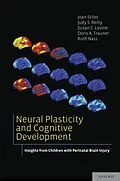The advent of modern neurobiological methods over the last three decades has provided overwhelming evidence that it is the interaction of genetic factors and the experience of the individual that guides and supports brain development. Brains do not develop normally in the absence of critical genetic signaling, and they do not develop normally in the absence of essential environmental input. The key to understanding the origins and emergence of both the brain and behavior lies in understanding how inherited and environmental factors are engaged in the dynamic and interactive processes that define and direct development of the neurobehavioral system. Neural Plasticity and Cognitive Development focuses on children who suffered focal brain insult (typically stroke) in the pre- or perinatal period which provides a model for exploring the dynamic nature of early brain and cognitive development. In most, though not all, of the cases considered, the injuries affect substantial portions of one cerebral hemisphere, resulting in patterns of neural damage that would compromise cognitive ability in adults. However, longitudinal behavioral studies of this population of children have revealed only mild cognitive deficits, and preliminary data from functional brain imaging studies suggest that alternative patterns of functional organization emerge in the wake of early injury. Neural Plasticity and Cognitive Development posits that the capacity for adaptation is not the result of early insult. Rather, it reflects normal developmental processes which are both dynamic and adaptive operating against a backdrop of serious perturbation of the neural substrate.
Autorentext
Joan Stiles, PhD, Emeritus Professor of Cognitive Sciences, University of California, San Diego Judy S. Reilly, PhD, Emeritus Professor of Psychology, San Diego State University, San Diego, CA Susan C. Levine, PhD, Stella M. Rowley Professor, Departments of Psychology, Comparative Human Development, and Committee on Education; Chair, Department of Psychology, University of Chicago, Chicago, IL Doris A. Trauner, MD, Professor of Neurosciences and Pediatrics; Chief, Pediatric Neurology, University of California, San Diego School of Medicine and Rady Children's Hospital San Diego, San Diego, CA Ruth Nass, MD Professor of Child Neurology, Child and Adolescent Psychiatry, and Pediatrics New York University School of Medicine New York, NY
Inhalt
PREFACE PART 1: NEUROBIOLOGY CHAPTER 1: Neuroplasticity and the Developing Brain CHAPTER 2: The Basics of Brain Development CHAPTER 3: Etiology and Neurological Effects of Perinatal Stroke PART 2: BEHAVIORAL STUDIES CHAPTER 4: Somatosensory and Motor Processes CHAPTER 5: Visuospatial Processes CHAPTER 6: Attention, Memory and Executive Functions CHAPTER 7: Early Communicative Development to First Words CHAPTER 8: Later Language Development: Syntax and Discourse CHAPTER 9: Plasticity of Overall Intellectual Functioning: Evidence from Standardized Tests PART 3: CLINICAL AND THEORETICAL IMPLICATIONS CHAPTER 10: Clinical Implications CHAPTER 11: Toward and Integrative Model of Neurobehavioral Development Index
